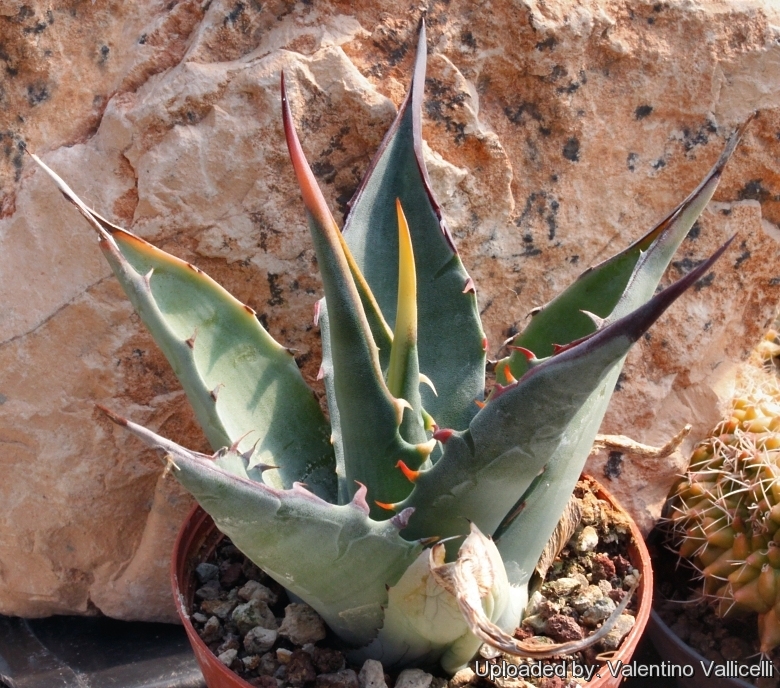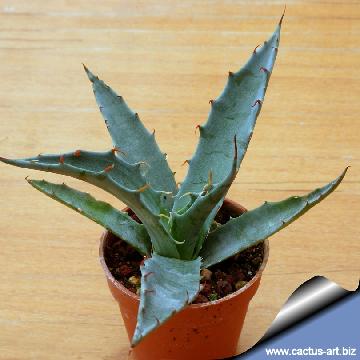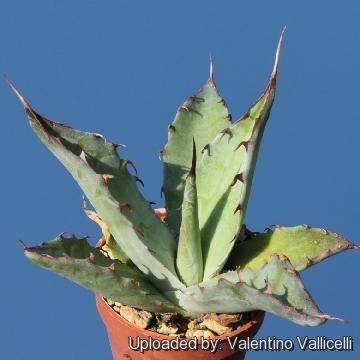
Agave avellanidens Photo by: Valentino Vallicelli
Rsarito, Baja California
Origin and Habitat: Limited to a small area in East-central Baja California between latitudes 200 and 28° N.
Type locality: Rancho Paraiso which is several miles south of the San Borja Mission.
Habitat: It grows in dry areas among bushy vegetation comprising Fouquieria, Yucca, and Pachycarmus.
Synonyms:
Description: Agave avellanidensSN|559]]SN|284]] is a medium sized agave similar to Agave shawiiSN|284]]SN|559]] var. goldmaniana (this two species meet and mingle southeast of Punta Prieta and are hardly distinguished from each other in their vegetative state )
Stem: Short, up to 50 cm long.
Rosette: Solitary, elongated 60-120 cm tall by 100-150 cm in diameter many-leaved and green.
Leaves: Broadly linear-lanceolate to ovate, thickly fleshy, rigid, little or not narrowed at the base, shortly acuminate, smooth, 40 – 70 long and 9 - 14 cm broad, green. Margins straight or undulate, frequently horny; marginal teeth straight or variously curved, variable in size and curvature, flattened, 5 - 15 mm, dusky grey over brown, mostly 1 - 3 cm apart, rather regularly spaced; terminal spine conical, strong, 2,5-4,5 cm, brown to greyish. strongly decurrent as horny margin.
Inflorescence: The inflorescence is a long narrow, small-bracted panicles (4-6 m tall). Part-iflorescence dense, large, globose with 25-35 flowering branches.
Flowers: Small flowers slender, 40-70 mm with short open tubes. Ovary 20-40 mm, neck sometimes constricted; Teppals light yellow, darking to an orange color as they dry out. Tube 4- 6 mm, lobes more or less equal, 16-24 mm.
Bibliography: Major references and further lectures
1) Howard Scott Gentry "Agaves of Continental North America" University of Arizona Press, 01/Feb./2004
2) Urs Eggli "Illustrated Handbook of Suculent Plants: Monocotyledons" Springer, 2001
3) Raymond M. Turner, Janice Emily Bowers, Tony L. Burgess "Sonoran Desert Plants: An Ecological Atlas" University of Arizona Press, 2005
 Agave avellanidens Photo by: Cactus Art
Agave avellanidens Photo by: Cactus Art Agave avellanidens Photo by: Valentino Vallicelli
Agave avellanidens Photo by: Valentino VallicelliCultivation and Propagation: Agave avellanidensSN|284]]SN|284]] is usually cultivated outdoors in rock gardens, in cactus and succulent gardens, in Mediterranean-style landscapes, in borders, or as a specimen. It needs full sun and a very well-drained, slightly acidic, sandy or gravely soil. As an ornamental it is also grown in containers where it stays much smaller than its outdoor brethren. Keep it in a cool, frost-free area in winter and put it out on the balcony or patio in summer. It grows fairly fast in summer if provided with copious water but allows to dry thoroughly before watering again. During the winter months, one should only water enough to keep the leaves from shrivelling. It do well in full sun or a lightly shaded area.
Scenography: These striking plants are wonderful when used for accent or simply to provide some all year round foliage and often used in a pot as a patio plant, can be moved around to change the scenery or position to give more shelter.
Warning: It can get large, and it is armed with needle-sharp spines.
Propagation: Seeds or suckers which often are found growing around the base of the plant. Remove the basal suckers (if available) in spring or summer and let the cuttings dry for a few days before inserting in compost.












